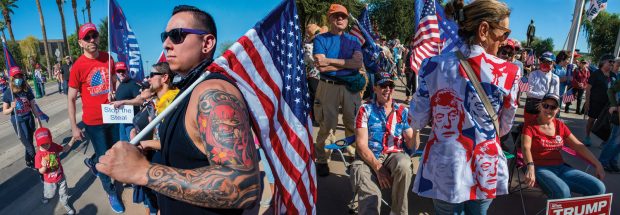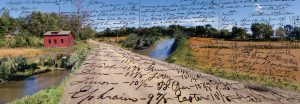
Above, a montage of protesters at a “Stop the Steal” rally supporting President Donald J. Trump in Phoenix on November 14, 2020, a week after his re-election bid was called in favor of Joe Biden by major news organizations. Photo by Stephen Marc
Of all the images Stephen Marc Smith ’76 creates, it is the ones of the people he has least in common with that may define him best.
A photographer, digital montage artist and Arizona State University art professor who adopted the name Stephen Marc professionally in 1979 after two other Stephen Smiths were accepted to the same exhibition, Marc recently published his fifth book, Street Cat Tales and Tangled Times: An American Journey Continues.
A photographic travelogue of more than 200 photos and digital montages, Street Cat Tales records the outpouring in our streets during a time of pandemic, racial and political division, gun violence and more. It is a follow-up to his award-winning American/True Colors, which recorded 12 years of life in the U.S. at some of its more fragile moments.
Whether he is photographing vibrant street scenes, a “Stop the Steal” rally or an immigration stare down, the way Marc gets the shot is part of the story. He is a Black man with a camera who has talked his way into white supremacist rallies, social justice protests and the hearts of Chicago gang members with his disarming approachability. His deft banter and innate friendliness have allowed him to capture a lifetime of photos that transport the viewer into the midst of volatile and sometimes disturbing situations.
“If I go and I photograph an event like this and then I simply leave with the photographs, I’m going to be illustrating a preconceived idea. I’m making some assumptions about what’s there,” Marc says. “If I interact, then I’m learning a little bit more about what’s really going on. I feel very fortunate when they share things with me.”
It is those unlikely connections that bewilder many people, including his wife, Ani Tung, who watched Jacob Chansley—the QAnon Shaman and January 6 rioter whose horned fur hat made him one of the most recognizable participants in the assault on the U.S. Capitol—bear hug her husband at a Trump rally in Phoenix.
“So you know him, too,” she said of Chansley, who since has served time in federal prison for obstruction of an official proceeding. Marc told his wife he had a civil discussion about cultural appropriation at another protest with Chansley, who couldn’t understand why the Native American community was upset with him even though his attire had its roots in their culture.

A photograph of the Nishnabotna Ferry House in Iowa is overlayed with an 1838 letter (courtesy of John L. Ford) from a Mississippi slave owner ordering shoes for his slaves. Their names and shoe sizes cover the roadway (Passage on the Underground Railroad). Photo by Stephen Marc
For his previous book, American/True Colors, Marc traversed the country in an old car, landing at gatherings and protests of all sorts. Some of the most powerful photographs came from a 2015 Ku Klux Klan rally at the South Carolina State House a week after the Confederate battle flag was permanently removed from the capitol grounds following the massacre of nine Black churchgoers in Charleston by a white supremacist. Yet because Marc engaged with both protesters and law enforcement before the rally, Klan supporters did nothing to impede him, a Black photographer who was a mere sucker punch away.
The most striking shot may be the one he took from behind the shoulders of a powerfully built state trooper—a Black officer assigned to keep peace among the factions. More than a dozen waving Confederate flags define the background. To the side is a banner featuring hooded Klansmen and a jarring phrase: “The Original Boys N the Hood.” The photo is soul-rattling because it is from the perspective of a Black law enforcement official. Once again, Marc’s fearlessness allows us to become voyeurs, at a safe distance.
His other books have examined different aspects of the American experience and Black lives. In particular, Passage on the Underground Railroad tells the story of attempts to aid escaped and enslaved people from the South before the end of the Civil War. Marc gained unprecedented access to some sites, among them the birthplace of abolitionist Harriet Tubman, and created digital collages by melding 21st-century photos with historical documents.

This 2022 montage depicts a stare down at the 2018 Families Belong Together rally at the Arizona State Capitol in Phoenix. Photo by Stephen Marc
One location had particularly deep meaning for him: The town of Canton, Mississippi, is in the area where he is told his great-great-grandmother was enslaved. Marc’s great-grandmother also lived there, and his grandmother was born there. Standing on the grounds of the local courthouse—a place in many towns where slaves were sold—Marc photographed it as it is today. Later, he digitally superimposed the shirtless torso of a Black man on top of a tree stump. “Any kind of raised area—whether it was steps or a stump or a pedestal—people were auctioned off of, so people could see them,” Marc says. On the man’s chest, he added lettering from an 1846 token, as if the man had been branded. “The token is from Charleston, South Carolina, an auction house that sold slaves,” he says.
Marc’s path has been anything but predictable. One of his earliest inspirations came when he was 11 years old and living in Chicago. He befriended Ira Harmon, a neighborhood boy who already was a skilled cartoonist. Marc was blown away by his friend’s focus, drive and utter desire to research everything that he drew.
“I remember the first time I went to his house, his mother said, ‘I’m sorry, he can’t come out.’ So I said, ‘What’s going on?’ She goes, ‘What’s today, Monday? He’ll be out on Thursday.’” When he asked what his friend had done wrong, “She said he told her to leave him alone for four days. He’s drawing. They even had to negotiate family meals. Later on, I could meet with him for like 15 minutes at the front door.”
The moment left an impression about curiosity and work ethic, and to this day the men remain close friends.
Marc’s interest in capturing images developed after he took a photography class in high school, at the University of Chicago Laboratory Schools. He soon thought of that as a career pursuit, but when he went to Pomona College, his parents strongly suggested another path. Psychology became his new direction.
Though the desire to take pictures never left him, Marc didn’t take a photography class until his junior year. It was taught by Leland Rice, a highly regarded photographer and curator who inspired him and remains a friend and mentor. Suddenly, Marc found himself trying to pursue three different passions: photography, psychology and sports.
Competing on Pomona-Pitzer’s track team as Stephen Smith, he was an NAIA All-American and five-time NCAA Division III All-American who still holds program records in the 200 meters (21.32 seconds) and 110-meter hurdles (14.19). A two-time team MVP, he later was inducted into the Pomona-Pitzer Athletics Hall of Fame. He loved track. But he found something he loved even more.
“I mean, I was cutting track practice in the afternoon to go photograph because of the lighting,” Marc says. “You know, my friends were asking me where I was. I was missing meals. I fell behind in a couple of my classes. And that was not like me. So I sat down and tried to figure out what was really going on.”
Of all his loves, he realized that photography had the strongest pull.
Marc eventually received a master’s in fine arts from the Tyler School of Art and Architecture at Temple University in Philadelphia. He taught at Columbia College Chicago for 20 years and has been on the faculty at ASU since 1998.
In 2021, Marc was named a Guggenheim Fellow in photography by the John Simon Guggenheim Memorial Foundation. He has won numerous awards, among them the 2021 gold medal for best photography book from the Independent Publishers Book Awards for American/True Colors. His work has been exhibited at the Museum of Contemporary Photography in Chicago, the Brooklyn Museum of Art, the Phoenix Art Museum, the National Underground Railroad Freedom Center in Cincinnati and the Chicago Cultural Center. He also has completed residencies at the Center for Photography at Woodstock and at the CEPA Gallery, both in New York state.

Firefighters taking part in a 2022 anti-vaccine mandate rally in Washington carry the U.S. flag from the Washington Monument toward the Lincoln Memorial in this digital montage. Photo by Stephen Marc
Marc says he captures such powerful photos not only by researching his subjects but also by preparing for what he might encounter.
“One thing I tell my students is that when you go out and photograph, I don’t care what you’re photographing, just take a moment and look in the mirror,” he says. “Think about how somebody like you dresses and the kind of equipment that you’re carrying. … The photographer is always the bad guy. We’re always doing something we’re not supposed to be. And so you need to get ahead of that so that you are prepared for the questions and the challenges that you’re going to get.”
